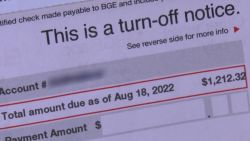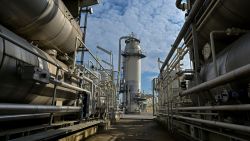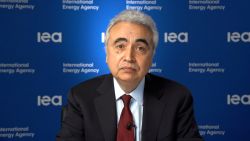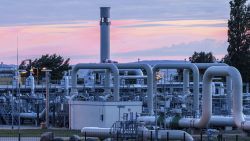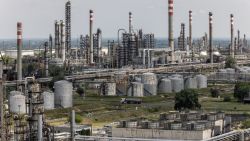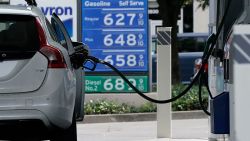Americans are already dealing with sticker shock at the grocery store and when filling up at the pump. Next up: Home heating bills.
US households that rely on natural gas for heating will spend an average of $746 to heat their homes this winter, up 30% from last winter, according to the Energy Information Administration. Retail natural gas prices are expected to hit the highest levels since the winter of 2005-2006.
That’s because the era of dirt-cheap natural gas — the most common fuel used to heat US homes — is over, for now at least. Natural gas futures have spiked 132% so far this year, recently touching levels unseen since 2008.
Industry experts warn that natural gas futures, and retail prices, could go even higher if it’s a very cold winter and Americans are forced to crank up the furnace.
“We’re going to be at the mercy of Mother Nature,” said Rob Thummel, senior portfolio manager at energy investment firm TortoiseEcofin.
The natural gas price spike threatens to add to the rising cost of living for everyday Americans and exacerbate inflationary pressures gripping the US economy. And industry analysts say President Joe Biden has few — if any — good options to address high natural gas prices.
If it does look to be a frigid winter, natural gas futures could “absolutely” double from current levels, Thummel said.
However, such a spike would most likely be temporary until temperatures warm up and suppliers are incentivized to increase output.
Elon Musk briefly worth more than ExxonMobil
Part of the problem is that although demand for natural gas has rebounded as the US economy has reopened from Covid shutdowns, supply has been slower to return.
One issue is that Hurricane Ida knocked offline the vast majority of oil and natural gas production in the Gulf of Mexico.
Another obstacle holding back supply: natural gas producers are focused on paying down debt and living within their means, according to Christopher Louney, vice president of global commodity strategy at RBC Capital Markets.
“It’s been a period of stubborn production growth,” Louney said.
Investors are also leery of providing more capital to oil-and-gas companies after the industry struggled mightily for the past decade. Energy was the S&P 500’s worst performing sector of the last decade — by a long shot.
Under pressure from the sustainable investing movement, many investors would prefer to deploy capital to companies that are viewed as being a permanent part of the solution to the climate crisis. That’s one reason Elon Musk’s net worth recently surpassed the market valuation of ExxonMobil (XOM), a stunning feat that seemed impossible just a few years ago.
“The pool of capital has grown more wary of investment in fossil fuels,” said Ira Joseph, global head of generating fuels and electricity pricing at S&P Global Platts. “The hot market has shifted from oil and gas to green portfolios: solar, wind turbines and battery storage.”
Private-equity billionaire warns of social unrest
Blackstone (BX) CEO Stephen Schwarzman said it’s getting harder for fossil fuel companies to borrow money to fund their expensive production projects, especially in the United States.
“If you try and raise money to drill holes, it’s almost impossible to get that money,” the private-equity billionaire told CNN International’s Richard Quest this week at an investment conference in Saudi Arabia.
Schwarzman warned energy prices could get so high that there will be “real unrest” that “challenges the political system.”
Natural gas prices have skyrocketed much higher in Europe and Asia. It has gotten to the point where some factories in Europe have been forced to shut down because they can’t pay the gas bill. China has resorted to rationing electricity, resulting in blackouts.
The gas shortage overseas may be helping to drive up US natural gas futures — even though that’s not justified.
“This market is bid on hysteria over the eurozone and Asia,” said Robert Yawger, director of energy futures at Mizuho Securities USA.
US not running out of gas
The good news is that even if it’s an extremely cold winter, the United States is not going to run out of natural gas. That’s in large part because America is the world’s leading producer of the fuel. And while natural gas inventories are lower than usual, they are not at alarming levels.
“There is no shortage here,” said Yawger, adding that there is a “zero percent chance” that the country runs out of natural gas.
And if this winter turns out to be warmer-than-usual, as government forecasters predict, natural gas futures could plunge.
In that scenario, Yawger said US natural gas futures could tumble back to the range of $3-$4 per million British Thermal Units (BTUs) — down by as much as half from current levels.
Still, today’s high natural gas prices are complicating the inflation outlook and casting further doubt on predictions from the Biden administration and Federal Reserve that the current price spikes would be a temporary phenomenon.
“Inflation is definitely more than transitory,” BlackRock (BLK) CEO Larry Fink said this week at the investment conference. “We’re in a new regime.”
‘There is no OPEC to call’
Asked about high natural gas prices, a White House official told CNN that Biden has directed his administration to monitor the supply of natural gas and take action to ensure families have access to the gas they need.
“We are particularly focused on the possibility of limited supply and storage in the northeast, which historically faces the highest prices,” the White House official said.
The American Rescue Plan, passed by Congress in March, included $4.5 billion in energy assistance funding for low-income families. The White House promised to work directly with states to get this funding to households facing high costs this winter.
But the Biden administration has few if any options to combat high natural gas prices, at least in the short term.
Unlike with oil, the United States does not have an emergency stockpile of natural gas it can release to cool off prices. And there is no cartel of producers with whom Biden officials can negotiate to produce more gas (not that that strategy has worked on the oil front recently).
“There is no OPEC to call,” said Thummel, the TortoiseEcofin portfolio manager.
In theory, the Biden administration could encourage more domestic production by relaxing environmental regulations. But such a move would take time to impact supply as well as undercut Biden’s climate agenda, the most progressive in US history.
In fact, these concerns about a shortage of natural gas are emerging just days before Biden travels to Scotland for COP26, an international summit aimed at weaning the world off fossil fuels.





